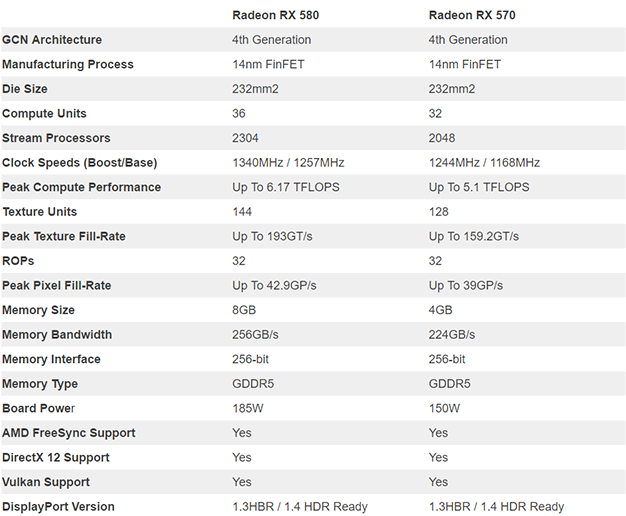Introducing The AMD Radeon RX 580 And RX 570
We’ve got the two premium cards in the lineup on hand for testing: the Radeon RX 580 and Radeon RX 570. In particular, we have the MSI Radeon RX 580 and RX 570 Gaming X in-house, both of which are customized and factory overclocked. In fact, virtually all of AMD’s board partners are at the ready with custom Radeon RX 500-series cards, so expect a varied array of RX 500-series cards to choose from once they hit store shelves.
AMD’s reference specifications are outlined below. Take a gander and then we’ll dig in a little deeper with the custom MSI cards we have on hand...
|

The AMD Radeon RX 580 and RX 570 are built around AMD’s Polaris 20 GPU, which is an updated revision of Polaris 10. Although it is very similar to the Polaris 10 used on the RX 480, AMD tells us this is actually a new GPU that has been tweaked to achieve higher clocks.
AMD's Polaris 20 GPU is comprised of approximately 5.7 billion transistors and has a die size of 232 mm2, just like Polaris 10. And the GPUs will also be manufactured using a 14nm FinFET process.
In comparison to AMD’s previous-generation architecture, Polaris has more powerful geometry processing capabilities, increased buffer sizes, more efficient delta color compression, tweaked memory controllers, asynchronous compute capabilities with prioritization, specialized temporal scheduling, and support for AMD technologies like Radeon Chill, FreeSync (and FreeSync 2), and HEVC and H.265 4K decoding. These updated models also have aggressive power tuning and support lower-power multi-monitor and idle power states. As such, AMD is positioning the Radeon RX 500 series as solid upgrades over cards that are 2-3 years old, for users that might not need the absolute highest-end graphics card, but want to take advantage of the more advanced features nonetheless.
Getting back to specifics, the Polaris 20 GPU at the heart of the Radeon RX 580 features 36 Compute Units, with a total of 2,304 shader processors. The reference specifications call for boost and base GPU clocks of 1340MHz and 1257MHz, respectively, with 8GB of GDDR5 memory (8Gb/s) linked to the GPU via a 256-bit interface. All told, the Radeon RX 580 offers up a total of 6.17 TFLOPs of compute performance with up to 256GB/s of peak memory bandwidth. And it can achieve this level of performance within a 185-watt typical board power that necessitates a single 8-pin supplemental PCI Express power feed. The older Radeon RX 480, which features a similar number of CUs and shader processors, and a similar memory interface, operates at lower clocks and offers up to 5.8TFLOPs of compute performance and 224GB/s of memory bandwidth. So, while the RX 580 is clearly an upgrade, it is not in a different league altogether.
Though it is based on the same chip, the Radeon RX 570 has four of the CUs disabled in the GPU (32 are active) and has 2048 active shader processors. Boost and base reference clocks are 1244MHz and 1168MHz, respectively, and cards will have 4GB of GDDR5 memory (7Gb/s) riding along on a 256-bit interface. At reference clocks, the peak compute performance of the Radeon RX 570 is 5.1TFLOPs with 224GB/s of memory bandwidth. Typical board power is 150W.
There are not likely to be many reference Radeon RX 500-series cards, however. The MSI cards featured here, for example, are fully customized and factory overclocked. And while they look similar at first glance, they feature somewhat different coolers and other accessories.
MSI outfits their Gaming X cards with what it calls the “Twin Frozr VI” cooler. The dual-slot Twin Frozr VI cooler sports high-density heatsinks, with dual cooling fans, and thick copper heatpipes that run from the cooler’s base up through the heatsink fins. We should also point out that the cooler’s base is made of copper and the entire assembly is nickel-plated, and outfitted with a premium thermal interface material. Though, you’ll notice the Radeon RX 570 has one fewer heat-pipe and lacks front and back-plates, so not all Twin Frozr VI coolers are created equal.
MSI’s Twin Frozr coolers have also been outfitted with proprietary “Torx 2.0 blade” ball-bearing fans that reportedly push more air than basic fan designs, while also generating more air pressure and less noise. MSI's Twin Frozr VI can even operate in a completely silent mode; when the GPU is not under load and running below 60'C, the fans will stop completely and produce no noise at all. The coolers have customizable LED lighting built-in as well, for users that like to personalize their systems.
Both the MSI Radeon RX 580 Gaming X and RX 570 Gaming X are factory overclocked as well. The Radeon RX 570 Gaming X will boost up to 1280MHz, while the RX 580 Gaming X will boost up to 1395MHz and features 8.1Gb/s memory. The outputs on the cards are similar, however. They both feature a pair of HDMI outputs, a pair of DisplayPort outputs, and a single DVI connector, all of which can me used simultaneously. Both cards also require a single 8-pin power connector.







